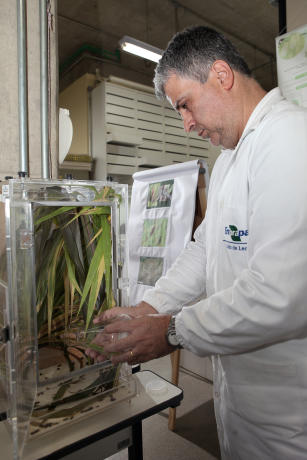Forage farming: impacts of CO2 and temperature alterations on spittlebugs
Forage farming: impacts of CO2 and temperature alterations on spittlebugs

Photo: Brigato, Márcio
The spittlebug, Mahanarva spectabilis, causes two types of injury to forage crops. The nymphs constantly suck the sap, causing the whole plant to yellow. The other type of damage is caused by the adult spittlebug, which feeds on shoot, leaves and sprouts, causing a phytotoxic response that varies among grass species used in pastures. Given the impact of this insect on forage crops, it is important to understand how global changes may influence its ecology and thus assess whether future increases in CO2 and temperature may lead to better adaptation of this pest. Thus, the objective of this project was to evaluate the effects of increased CO2 levels and temperature on the biology of M. spectabilis fed elephant grass and brachiaria grass. There was generated information about biomes in which the insect could either: a - continue to be the key pest; b- aggravate the situation, by reducing its life cycles thus leading to an increase in the number of annual generations and c- population reduction of the pest-insect. In the three situations the project had the applicability of indicating the main producing regions that in the future scenario may have the problem aggravated or mitigated.
Ecosystem: Amazonic, Atlantic Forest, Cerrados Region
Status: Completed Start date: Wed Dec 01 00:00:00 GMT-03:00 2010 Conclusion date: Mon Nov 30 00:00:00 GMT-03:00 2015
Head Unit: Embrapa Dairy Cattle
Project leader: Alexander Machado Auad
Contact: alexander.auad@embrapa.br
Keywords: Mudanças climática, Insetos-praga, Capim elefante, Braquiária
